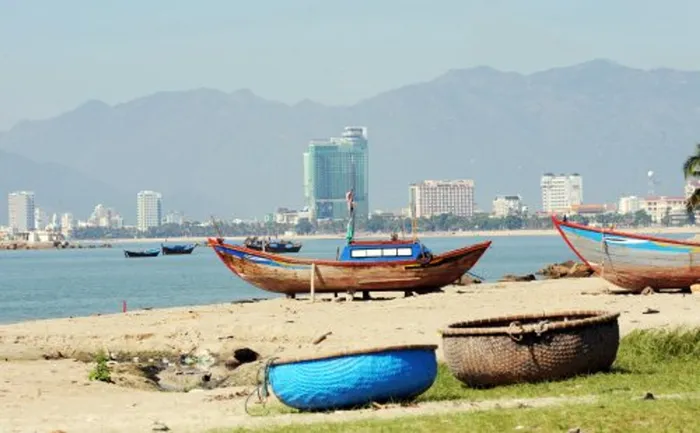Vietnam tourism threatens rare monkeys

Hon Heo, Vietnam - Before he settled on this rocky, jungle-covered peninsula in central Vietnam, Canadian Sylvio Lamarche did not much like monkeys.
But then Lamarche moved to Vietnam, got married, built a dozen bamboo huts on a beach and started a resort.
Three years ago, a guest spotted some monkeys clambering on the cliffs on the far side of the road, and took a photo.
They turned out to be endangered Black-shanked Douc langurs. Today, Lamarche finds himself the unofficial guardian of a troupe of at least 100 primates that call the mountains behind his resort home.
"They're actually quite pretty, and it turns out they're quite special," Lamarche said. "Throughout Indochina where these kinds of langurs are, they are all interrelated, except for my langurs."
Realizing he has just called the animals "my langurs," Lamarche corrects himself: "The ones on the mountain here. Which I call my langurs. Because they are my langurs."
Lamarche's resort, Jungle Beach, is now an official research station for the Frankfurt Zoological Society's (FZS) primate conservation programme in Vietnam. A primate biologist from Danang University lives there full-time to study the monkeys.
But the langurs face pressure from accelerating development. The beach city of Nha Trang, 60km to the south, is one of the biggest tourism centres in Vietnam.
In neighbouring Yen Phuc province, a company from Brunei received approval for a $4,3-billion mega-resort. And a new road is under construction along the Hon Heo Peninsula, potentially threatening the langurs' habitat.
The Khanh Hoa Province People's Committee, the province's governing body, is strongly promoting tourism development, hardly surprising in the impoverished country, where the per capita gross domestic product has just reached $1 000.
The government's eagerness for more hotels makes even the word "conservation" sensitive. To gain approval for the project at Jungle Beach, the scientists changed the wording of their proposal from "conservation" to "research."
"Very often, see a conflict between tourism development and conservation," said Tilo Nadler, the primate biologist who heads the FZS's programmes in Vietnam. "It will take a long time to improve awareness, and to explain that tourism development and conservation should go together."
Each morning and evening, staff at Jungle Beach take turns at a telescope, scanning the mountain face for langurs. If any are spotted, guests are called to come observe them. Lamarche says monkey watching is "mandatory" for his guests.
Observers record the number of animals, their size, which rock they were spotted on, and which direction they were heading. The fact that Black-shanked Douc langurs spend any time on rocks and not just on trees was first discovered at Hon Heo.
Other surprises have been forthcoming. Unlike other Black-shanked Doucs, the ones here often have white marks on their forearms and red ones on their hind legs.
Genetic material in stool samples shows that this population must have been isolated from their cousins in Vietnam and Cambodia for some 1 000 years. At the time, the peninsula belonged to the now vanished Hindu kingdom of Champa.
The langurs live in troupes of a single male with three to five females and young. Adolescent males form roving bands and several times a year, different troupes come together. Some females are taken over by aggressive adolescents, or are exchanged between groups, mixing the genetic pool and preventing inbreeding.
Hon Heo totals 55 000 hectares of jungle-covered mountains. While just over 100 langurs have been sighted at Jungle Beach, the number living deeper in the peninsula could total several times that.
But the peninsula has changed since Lamarche first arrived in the late 1990s. Back then, there was no road, and it took him three days of following tracks on his motorbike just to find the beach.
"There was nobody there," Lamarche says. "I mean, nobody. It was paradise."
Jungle Beach is an old-fashioned bare-bones beach resort, the sort of place where a long-haired backpacker might have crashed in the 1970s. There is no swimming pool and no hot water, the rooms are bamboo shacks with thatched roofs. Guests eat the same food, sitting at a communal table.
Now large-scale industrial tourism is encroaching on Lamarche's territory. In 2008 a Japanese hotel chain, built a five-star resort cluster of tile-roofed concrete bungalows with a swimming pool next door.
Meanwhile, authorities are bulldozing a road down the peninsula, which will inevitably bring new visitors and more development.
"There's 15 kilometres of road," said Lamarche. "That's quite a bit of beach area, quite a bit of mountain area, and quite a bit of access to the jungle to go and pillage and destroy some more."
Several local residents said if the langurs are being harassed, they are not the ones at fault.
"No one here catches the monkeys," said Nguyen Thi Thong Mai, 24, who lives in the village of Ninh Phuoc, down the beach from Lamarche's resort. "We don't go into the forest to cut trees."
Mai and several of her friends said they had seen the langurs, and agreed with the idea that the government should protect them.
Lamarche said that illegal hunting, logging and charcoal manufacture occur in the mountains, though he believed most of the offenders came from a different province.
Lamarche understands why local authorities would privilege development over conservation.
"There's a lot of hungry people in this country," Lamarche said. "You cannot neglect the poor for wildlife."
But in the long run, Nadler said, the tourism boom will not last if the country fails to protect the environmental treasures that attract tourists. - Sapa-dpa